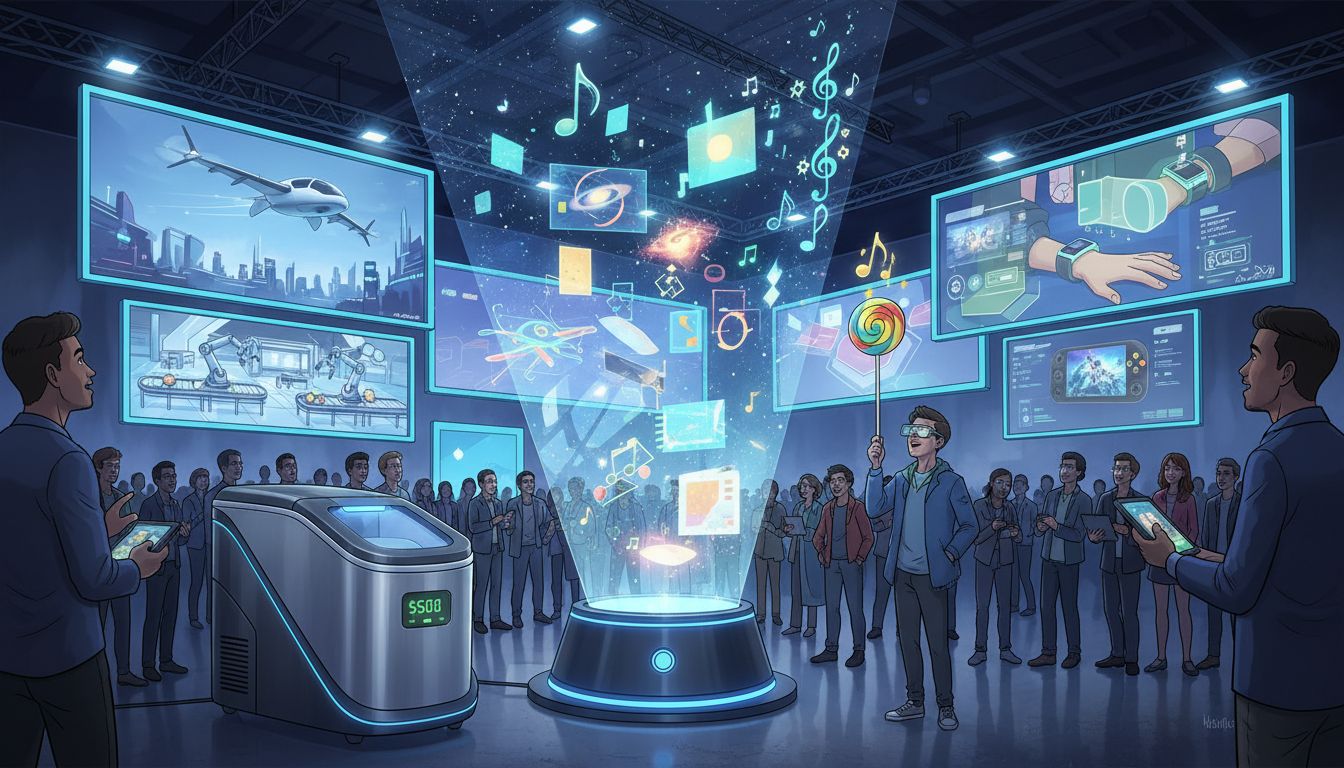The AI Chatbot Expansion is revolutionizing the way we interact with technology, and Google’s Bard is at the forefront of this transformation. As one of the most advanced virtual assistants in existence, Google Bard offers a glimpse into what the future holds for AI systems and chatbot technology.
In this blog post, we’ll delve into recent announcements made by Alphabet CEO Sundar Pichai during a meeting for app developers and engineers about their ambitious plans to expand Google Bard. We will also discuss how these developments reinforce their commitment to becoming an AI-first company.
Furthermore, you’ll learn about innovative features that set Google Bard apart from its competitors – such as generating images through written instructions and automatic captioning capabilities designed to enhance user experience. Finally, we’ll examine how major players like OpenAI, Microsoft, Meta are vying for dominance in the generative AI market and explore opportunities arising from increased competition within this rapidly evolving field.
Table of Contents:
- Google Bard AI Chatbot Expansion
- Meeting for App Developers and Engineers Announcing the Expansion
- Alphabet CEO Sundar Pichai Emphasizing Their Journey as an AI-First Company
- Innovative Features of Google Bard
- Generating Images Through Written Instructions
- Automatic Captioning Enhancing User Experience
- Competition in Generative AI Market
- Innovative Features of Google Bard
- Competition in the Generative AI Market
- FAQs in Relation to Ai Chatbot Expansion
- Conclusion
Google Bard AI Chatbot Expansion
As part of its ongoing efforts to make artificial intelligence more accessible and useful, Google has recently expanded its generative AI chatbot, Bard, by launching Japanese and Korean versions. This development is a significant step in the company’s plan to make the English version available in over 180 countries and regions while also expanding language capabilities to include up to 40 languages soon.
Meeting for App Developers and Engineers Announcing the Expansion
In a recent meeting for app developers and engineers, Google announced this exciting expansion as they continue on their journey towards becoming an AI-first company. The introduction of new language options will enable even more users around the world to experience Bard’s innovative features firsthand.
Alphabet CEO Sundar Pichai Emphasizing Their Journey as an AI-First Company
Sundar Pichai, Alphabet’s CEO, underscored that they are now entering a thrilling stage in their AI-centered journey. With opportunities arising from increased competition within the generative AI market involving major tech firms such as OpenAI, Microsoft, and Meta among others – there is immense potential for making artificial intelligence more helpful for individuals, businesses, and communities worldwide.
Innovative Features of Google Bard
Beyond merely providing text-based assistance like traditional chatbots do, Google Bard showcases the power of artificial intelligence by generating original images with automatic captioning based on written instructions provided by users. This feature demonstrates how helpful AI can be for individuals, businesses, and communities worldwide.
Generating Images Through Written Instructions
Bard’s ability to generate images through written instructions sets it apart from other chatbots in the market. Users simply need to provide a detailed description of what they want to see, and Bard will create an image that matches their request as closely as possible using its advanced AI algorithms.
Automatic Captioning Enhancing User Experience
In addition to creating images based on user input, Bard also offers automatic captioning capabilities that further enhance the overall experience. By providing relevant captions for generated images, users can better understand and appreciate the content created by this innovative AI chatbot.
Competition in Generative AI Market
The generative AI market is becoming increasingly competitive as major tech firms like OpenAI, Microsoft, and Meta (formerly Facebook) continue developing their own cutting-edge technologies. As these advancements unfold, new opportunities arise for companies like Google who aim to make artificial intelligence more accessible globally while enhancing user experiences across various platforms.
Google Bard AI Chatbot Expansion has opened up new possibilities for app developers and engineers, allowing them to create innovative applications with the help of Alphabet’s advanced Artificial Intelligence technology. With that in mind, let us now explore some of the features offered by Google Bard which can make user experience even better.
Google has expanded its generative AI chatbot, Bard, by launching Japanese and Korean versions as part of their plan to make the English version available in over 180 countries and regions while also expanding language capabilities. Beyond providing text-based assistance like traditional chatbots do, Google Bard showcases the power of artificial intelligence by generating original images with automatic captioning based on written instructions provided by users.
Innovative Features of Google Bard
The innovative features of Google Bard enable it to generate original images with automatic captioning based on written instructions provided by users. These capabilities showcase how helpful artificial intelligence can be for individuals, businesses, and communities worldwide.
Generating Images Through Written Instructions
One of the most exciting aspects of Google Bard is its ability to create unique images simply by following user-provided text descriptions. This feature allows users to obtain custom visuals without needing any design skills or specialized software. For example, a user could type in “an orange cat sitting on a blue couch,” and the AI chatbot would produce an image that matches this description as closely as possible.
This powerful capability has numerous applications across various industries such as marketing, education, entertainment, and more. By leveraging Google Bard’s generative AI technology, professionals can save time and resources while producing high-quality visual content tailored to their specific needs.
Automatic Captioning Enhancing User Experience
In addition to generating images from textual input, Google Bard also offers automatic captioning functionality that further enhances the user experience. When creating an image using written instructions, the AI chatbot will automatically generate relevant captions describing the generated visual content accurately.
- Educational purposes: Teachers can use auto-captioned images created by Google Bard for visually impaired students or those who need additional context when learning new concepts.
- Social media: Businesses can leverage automatically generated captions alongside their custom visuals for improved engagement on platforms like Instagram or Facebook where engaging captions are crucial for success.
- User-generated content: Communities can benefit from auto-captioning features by making it easier for members to contribute and share images with meaningful descriptions, fostering better communication and understanding.
With these innovative features, Google Bard showcases the potential of AI technology in revolutionizing how we create and consume visual content. As Alphabet CEO Sundar Pichai emphasized during the recent announcement, their journey as an AI-first company aims at making artificial intelligence more helpful for individuals, businesses, and communities worldwide.
The innovative features of Google Bard have enabled it to stand out in the AI chatbot market, and its continued development will surely benefit users. Competition is also growing in the generative AI market as major players such as OpenAI, Microsoft & Meta compete for a share of this lucrative space.
Google Bard is an AI chatbot that can generate original images with automatic captioning based on written instructions provided by users. This innovative feature allows individuals, businesses, and communities to obtain custom visuals without needing any design skills or specialized software, saving time and resources while producing high-quality visual content tailored to their specific needs. The auto-captioning functionality enhances the user experience in various industries such as education, social media, and user-generated content.
Competition in the Generative AI Market
The generative AI market is heating up, with major tech firms like OpenAI, Microsoft, and Meta (formerly Facebook) all competing to develop cutting-edge technologies. This intense competition brings new opportunities for companies like Google that aim to make artificial intelligence more accessible globally.
Major Players Competing in the Space
- OpenAI: Known for its groundbreaking language model GPT-3, OpenAI has been a frontrunner in the field of generative AI. The company continues to push boundaries by developing advanced models capable of understanding context and generating human-like text based on user input.
- Microsoft: Microsoft’s investment in AI research has led to innovations such as their Turing-NLG model, which boasts impressive natural language generation capabilities. They also recently acquired Nuance Communications, a leader in conversational AI technology.
- Meta: Meta’s advancements include projects like BlenderBot, an open-domain chatbot designed to engage users with diverse topics while maintaining coherent conversations. Their ongoing work focuses on improving dialogue systems and expanding applications across various industries.
New Opportunities Arising from Increased Competition
The race among these industry giants not only drives innovation but also creates numerous opportunities for businesses and consumers alike. Some potential benefits arising from this competitive landscape include:
- Better User Experience: As companies compete to create more sophisticated chatbots, users can expect improved interactions with these digital assistants, leading to a more seamless and enjoyable experience.
- Wider Language Support: As evidenced by Google’s Bard expansion, the demand for multilingual AI chatbots is on the rise. This will enable businesses to cater to diverse audiences and help bridge language barriers in global communication.
- New Applications: With generative AI technology advancing rapidly, we can expect innovative applications across various industries such as healthcare, education, customer service, and entertainment – making artificial intelligence an integral part of our daily lives.
Staying at the forefront of technological innovation, Google strives to make its products available to users all over the world through initiatives such as Bard’s new Japanese and Korean versions. As they continue expanding their offerings with initiatives like Bard’s new Japanese and Korean versions, Google remains committed to its mission of making AI accessible and helpful for individuals, businesses, and communities around the globe.
Major tech firms like OpenAI, Microsoft, and Meta are competing to develop cutting-edge generative AI technologies. This competition creates opportunities for businesses and consumers alike such as better user experience with chatbots, wider language support, and new applications across various industries. Google is working tirelessly to stay ahead of the curve while ensuring that their innovations reach users worldwide through initiatives like Bard’s new Japanese and Korean versions.
FAQs in Relation to Ai Chatbot Expansion
What is the future of AI chatbots?
The future of AI chatbots lies in their ability to provide more personalized and human-like interactions, as well as integrating with various platforms and services. Advancements in natural language processing, machine learning, and sentiment analysis will enable chatbots to better understand user needs and offer tailored solutions. The increasing adoption of voice assistants also points towards a growing demand for conversational interfaces.
What is the controversy with OpenAI?
OpenAI has faced controversies related to its powerful language models like GPT-3 due to concerns about potential misuse, biases present within the model’s training data, and accessibility issues. Critics argue that these models could be used maliciously or unintentionally perpetuate harmful stereotypes. Additionally, some have raised questions about whether OpenAI’s exclusive licensing deal with Microsoft limits access to cutting-edge technology.
What is the advantage of AI in chatbots?
AI-powered chatbots offer several advantages over traditional rule-based bots: they can understand complex queries using natural language processing (NLP), learn from user interactions through machine learning algorithms, provide context-aware responses based on previous conversations or external information sources, handle multiple tasks simultaneously by leveraging advanced cognitive capabilities such as memory networks or reinforcement learning techniques.
Is an AI chatbot a good project?
Developing an AI chatbot can be a rewarding project if it addresses specific business needs or enhances customer experience. It provides opportunities for developers to gain expertise in NLP technologies while creating innovative solutions that improve efficiency and productivity across industries such as retail, healthcare, finance among others. IBM‘s guide on building successful chatbots can serve as a helpful resource.
Conclusion
Google’s Bard AI Chatbot Expansion was recently announced at a meeting for app developers and engineers. Alphabet CEO Sundar Pichai emphasized their journey as an AI-first company, showcasing the innovative features of Google Bard such as generating images through written instructions and automatic captioning, which enhances user experience.
The generative AI market is highly competitive with major players such as OpenAI, Microsoft, and Meta competing in the space. However, this increased competition also brings opportunities for growth and development within the industry.
Google’s expansion in AI chatbots shows that there is significant potential for innovation in this field. As the industry develops and rivalry from other tech firms rises, it will be intriguing to observe how these advancements influence conversational interfaces in the future.






